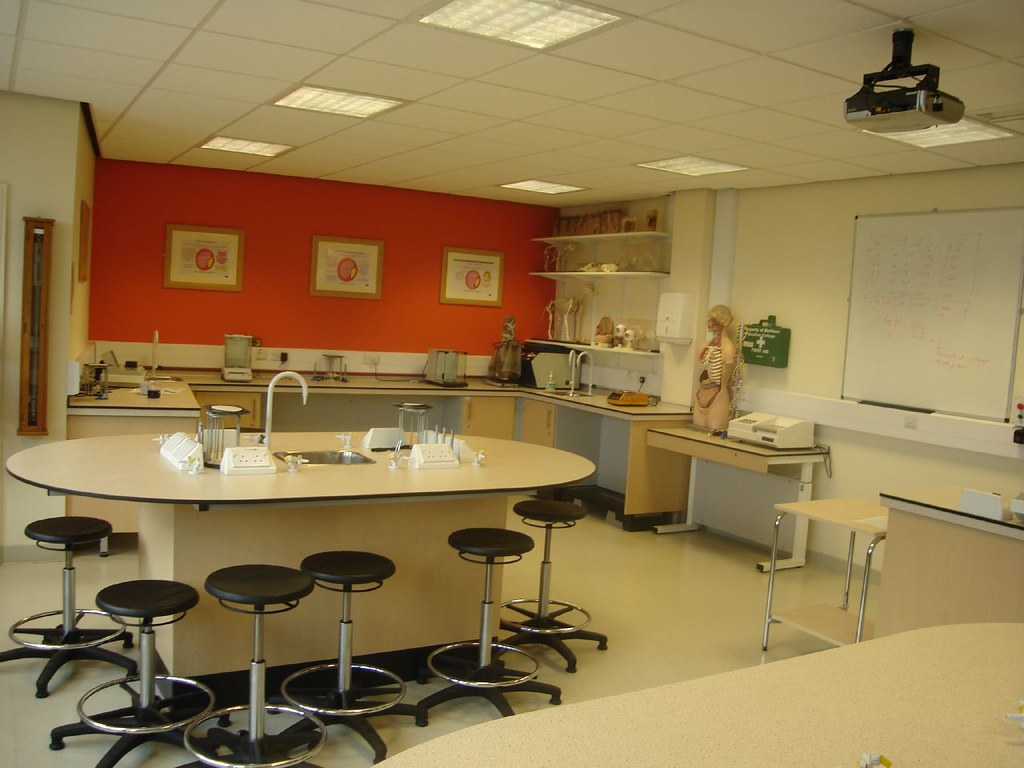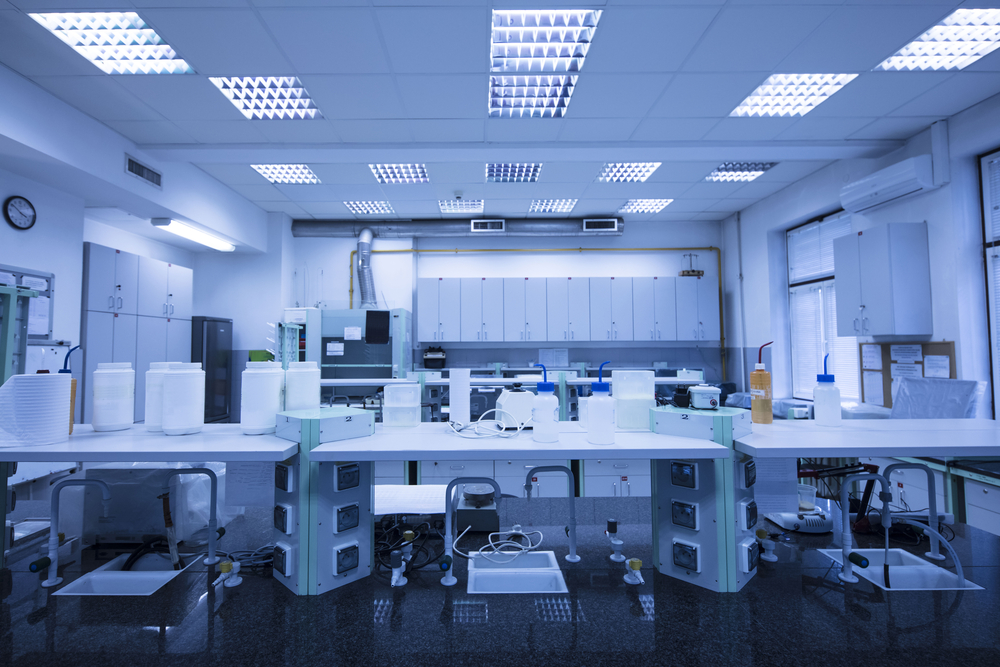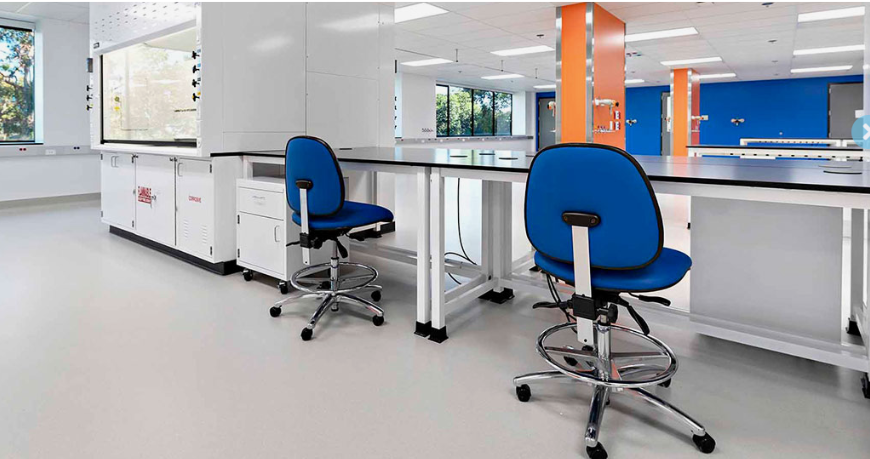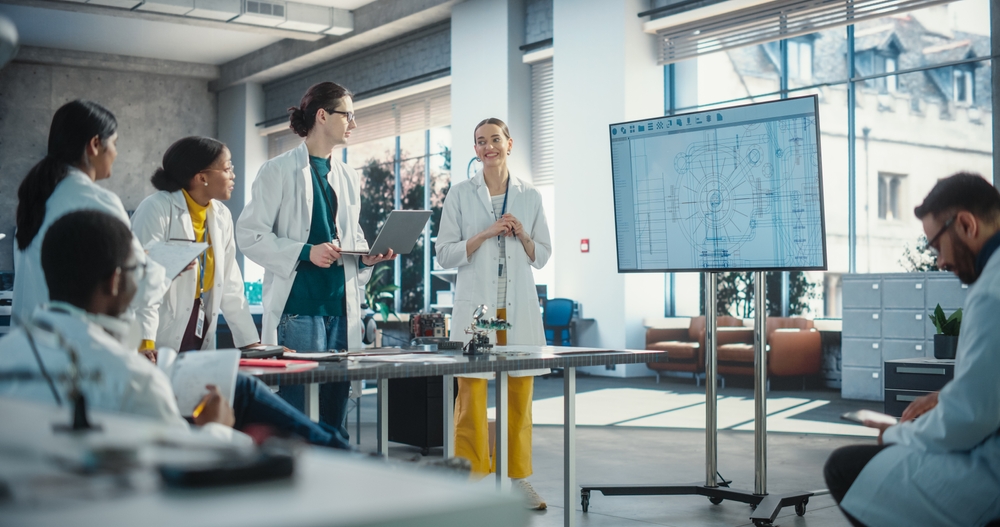
When looking at the innovative designs for science laboratory tables, the modern trend to create spaces that prioritize the well-being and productivity of staff must not be overlooked. In this article, we’ll explore this shift, which is accompanied by the emergence of innovative equipment and technologies that enhance laboratory functionality.
One such innovation is the move towards modular and mobile science laboratory tables, which offer flexibility and adaptability to meet the diverse needs of modern research and experimentation. Read on as we highlight the essential features of these tables and how they contribute to creating versatile and efficient lab environments.
Science Laboratory Tables for Productivity and Personnel Well-Being

Labs are increasingly adopting open floor plans without dividers and with minimal or no panel workstations. They are moving away from industrial laboratory spaces towards a more people-friendly and practical working environment.
Despite the emergence of novel equipment and technologies, individuals remain the most valuable assets of a science laboratory. Organizations that prioritize discovery and innovation must create environments that nurture and facilitate their most valuable resources, namely their personnel.
Therefore, whether choosing science laboratory tables, lab benches, fume hoods or other lab furniture, people-centric design in creating workspaces that support the well-being and productivity of employees is vital.
It involves the “psychology of place,” which considers how social activities, cultural meaning, and physical attributes shape our experience of a space.
- Integration of Elements: A successful design integrates social activities, cultural meaning, and physical attributes to create a space that meets both physical and emotional needs, while meeting ADA requirements.
- Community Focus: Designing for people involves considering the needs and preferences of all individuals who will use the space, from top executives to maintenance staff. This approach fosters a sense of community and belonging.
- Authenticity over Superficiality: Rather than relying on superficial elements like signs or generic art, a people-centric design focuses on creating an authentic culture within the workspace.
- Benefits for Businesses: Prioritizing relationships and connections through people-centric design can lead to higher employee satisfaction, which in turn can improve retention rates and overall business performance.
Interpersonal relationships at work are a key factor in employee job satisfaction, and having a “work best friend” can increase productivity and innovation. This highlights the tangible benefits of fostering a sense of community within the workplace.
Additional Reading: Growth in Laboratory Design: Mobility, Sustainability, and a Reflection of How We Think
Innovative Designs for Science Laboratory Tables

Science laboratory table designs should focus on ergonomics, functionality, safety, versatility, and adaptability to modern lab needs.
Unlike fixed work benches of the past, modular, often mobile, science lab tables of the future can be made more versatile and multi-functional through innovative design and technology integration. Here are some ideas:
1. Modular Components
Design tables with modular components that can be easily rearranged or replaced to accommodate different experiment setups or research needs. This could include interchangeable work surfaces, storage units, and equipment mounts. Science laboratory tables with modular designs allow for easy expansion or reconfiguration of the lab space as required, providing flexibility for future changes, whether for a science classroom or a research laboratory.
2. Mobile Science Laboratory Tables
Tables with lockable casters allow for easy reconfiguration of the lab layout, facilitating collaborative work and accommodating different experiment setups.
3. Integrated Technology
Incorporate technology into the science laboratory tables, such as interactive devices, built-in power outlets, USB ports, data connections, and charging stations to support the use of electronic devices and equipment.
4. Adjustable Configuration
Make laboratory tables configurable to different shapes and sizes, allowing them to be used for various work areas for experiments and other activities.
5. Built-in Storage Solutions and Organization
Include built-in storage cabinets, shelves, drawers, pull-out trays, and organizers to keep equipment and supplies easily accessible and organized.
6. Flexible Seating Options
Design science laboratory tables with flexible soft seating options, such as integrated stools or benches, that can be easily moved or adjusted to accommodate different users and activities.
7. Collaboration Features
Include features that facilitate collaboration, such as whiteboard surfaces, shared displays, or integrated communication tools.
8. Safety Features
Science laboratory tables with safety features such as rounded edges, non-slip surfaces, and chemical-resistant materials help prevent accidents and ensure a safe working environment.
9. Multipurpose Surfaces
Use tabletop surfaces that are durable and suitable for various tasks, such as writing, cutting, and chemical work, to maximize the functionality of the table.
By incorporating these basic features, modular science lab tables can be made more versatile and multi-functional, enabling them to adapt to the changing needs of modern research and experimentation.

Additional Essential Features for Modern Science Laboratory Tables
It has become common for science laboratories to facilitate multiple fields of R&D. Therefore, innovative designs should also include the following features:
Vibration Dampening
Vibration dampening is essential for fixed and portable science laboratory tables to ensure the accuracy and reliability of sensitive equipment.
Vibrations, whether from nearby machinery or foot traffic, can disrupt delicate experiments and measurements, leading to inaccurate results.
By incorporating vibration dampening features, such as shock-absorbing materials or isolation mounts, portable lab tables can minimize the impact of vibrations, providing a stable and controlled environment for experiments.
This improves the quality of data and extends the lifespan of the equipment by reducing wear and tear caused by vibrations.
Overall, vibration dampening is crucial for maintaining the integrity and effectiveness of portable science laboratory tables in various research and educational settings.
Sound Suppression
Sound suppression is a crucial feature on mobile science laboratory tables in modern labs because it enhances comfort and concentration for lab personnel.
By reducing noise levels from equipment such as centrifuges and pumps, sound suppression creates a quieter environment, allowing researchers to focus better on their work.
It also helps maintain confidentiality in sensitive lab settings and ensures compliance with noise level regulations. Additionally, sound suppression contributes to the optimal performance of sensitive lab equipment and helps prevent noise pollution in the lab environment.
Ergonomics — Adjustable legs
Modern science laboratory tables are designed to be ergonomic and functional. Adjustable legs can indeed make science laboratory tables more ergonomic and are important for several reasons.
Firstly, adjustable legs allow users to customize the table height to suit their needs, promoting proper posture and reducing the risk of musculoskeletal strain and injury. This is particularly critical in laboratory settings, where users may spend long hours conducting experiments.
Secondly, adjustable legs can accommodate users of different heights, ensuring that the table is comfortable and accessible for everyone, including those in wheelchairs.
Additionally, adjustable legs can facilitate collaboration and flexibility in the lab, as tables can be easily adjusted to accommodate different tasks or users.
Overall, adjustable legs can greatly improve the ergonomics of science laboratory tables, promoting a safer, more comfortable, and more productive working environment.
Safe Work Surfaces for all R&D Activities
Chemical-resistant work surfaces are crucial for science lab tables, especially in modern labs that integrate multiple fields of research and development, for several reasons.
Firstly, these surfaces protect the table from damage caused by corrosive chemicals, ensuring the longevity of the table and reducing the need for frequent replacements. This is particularly important in labs that work with a wide range of chemicals, as exposure to corrosive substances can quickly degrade standard table materials.
Secondly, chemical-resistant surfaces promote a clean and hygienic working environment that protects researchers and lab personnel from exposure to hazardous chemicals. Spills or splashes of corrosive substances can pose serious health risks if not properly contained, making it essential to have a surface that can withstand such incidents.
Thirdly, chemical-resistant surfaces are easier to clean and disinfect, reducing the risk of contamination and ensuring that experiments are conducted in a safe and sterile manner.
Overall, chemical-resistant work surfaces on science laboratory tables are essential for science lab tables in modern labs that integrate multiple fields of research and development. They protect the table, researchers, and the environment from the harmful effects of corrosive chemicals, ensuring a safe and efficient laboratory environment.
It is essential that the materials used in the construction of lab furniture are robust and adjustable due to its high cost and customizability. The right type of furniture and surface material are essential when selecting lab furniture that will last more than a decade.
Therefore, coatings that are chemically and biologically resistant are essential. The most suitable materials for modern science laboratory tables include:
- Stainless steel
- Powder coated steel
- Epoxy resin
- Phenolic resin
- Plastic laminate
- Polypropylene
- Wood (Butcher block)
Gas and Air Supply to Mobile Science Laboratory Tables
Articulated robot arms or ceiling-mounted gas and air supply systems can be a viable alternative to fixed piped supplies. These systems use flexible hoses or arms that can be extended to reach the lab tables and retracted when not in use. Here are some advantages of using these systems:
- Flexibility: Articulated arms can be adjusted to reach different areas of the lab, providing flexibility in lab layout and experiment setup.
- Easy Installation: Ceiling-mounted systems are relatively easy to install compared to fixed piped supplies, as they require minimal structural changes.
- Space-saving: These systems help save space in the lab by eliminating the need for bulky gas pipes running along the floor or walls.
- Safety: Ceiling-mounted systems can reduce the risk of tripping hazards associated with floor-mounted gas pipes or hoses.
- Adjustable Flow: Some systems allow for adjustable flow rates, providing precise control over the gas and air supply to each table.
- Easy Maintenance: These systems are typically easy to maintain, with hoses and components easily accessible for inspection and replacement.
However, it’s important to consider the cost of these systems, as well as any additional safety measures that may be required. Consulting with a lab safety expert or engineer can help determine the best solution for your lab’s needs.

Eco-Friendly & Sustainable
Science laboratory tables of the future can be made more eco-friendly through various design and material choices. Here are some ideas:
Sustainable Materials: Use eco-friendly materials such as recycled or renewable resources for table construction. For example, tables made from recycled plastics or bamboo can reduce the environmental impact of production.
Energy Efficiency: Incorporate energy-efficient features into the tables, such as LED task lighting or power-saving modes for integrated technology.
Minimalistic Design: Design tables with a minimalistic approach to reduce material waste and energy consumption during manufacturing.
Recyclability: Ensure that the materials used in the tables are easily recyclable at the end of their lifespan.
Durability and Longevity: Build tables to be durable and long-lasting, reducing the need for frequent replacements and minimizing waste.
Low-toxicity Materials: Use materials that are low in toxicity to minimize the environmental impact of manufacturing and disposal.
Carbon Footprint Reduction: Consider the carbon footprint of the table’s lifecycle, from production to disposal, and implement measures to reduce it, such as sourcing materials locally or using renewable energy in manufacturing.
Modularity: Design tables to be modular so that components can be easily replaced or upgraded, extending the table’s lifespan and reducing waste.
By incorporating these eco-friendly features, science lab tables of the future can help reduce the environmental impact of laboratory operations and promote sustainability in research and education.

How To Choose an Expert Laboratory Table Provider
When looking to equip a science laboratory with tables, finding the most qualified company to provide guidance and top quality lab furniture might be the greatest challenge.
The cost, new product development, practicality, technical proficiency and quick delivery times are some essential qualities to look for in a capable supplier of modular laboratory furniture.
However, the laboratory environment is complex, and the R&D operations of the lab technicians are sophisticated. Focusing on the lowest price might turn out to be a costly mistake. Cheap and inferior science laboratory tables and casework will likely cause costly problems, and need replacement soon.
Choose an accredited company that designs, engineers, manufactures, and installs lab furniture, while also offering excellent after sales service.
Bottom Line
Innovative designs for science laboratory tables play a crucial role in creating modern, efficient, and user-friendly lab environments. The shift towards modular and mobile tables reflects a broader trend in laboratory design towards flexibility, adaptability, and user-centricity.
By incorporating features such as adjustable heights, integrated technology, and chemical-resistant surfaces, these tables enhance the functionality and usability of modern labs across various fields of research. As laboratories continue to evolve, it is clear that innovative designs for laboratory furniture will remain a key focus area, driving advancements in research and experimentation.





